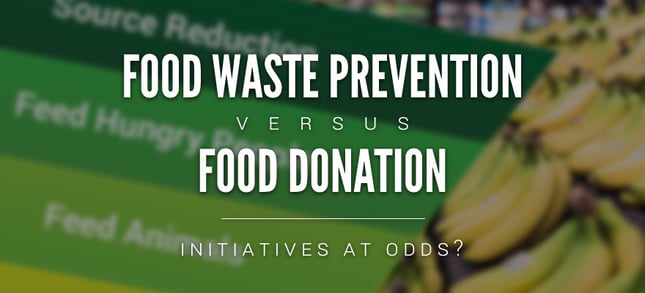Food Waste Prevention vs. Food Donation: Initiatives at Odds?

Earlier this month I attended the Feeding America food recovery summit held in Washington, D.C. Since I focus on food waste prevention, I’m sometimes asked if there’s tension emerging between prevention and recovery. After all, if we prevent food waste from happening, doesn’t food recovery lose out?
In theory, yes. Any operator who notices they’re donating the same item repeatedly should take a very close look at controlling it. For example, if there are 5 dozen bagels leftover and donated every day, it’s time to change the standing bagel order, reduce the wasted food and donate less.
But reality is rarely so straightforward. Daily specials don’t sell. Guests fail to appear in anticipated numbers for a seated banquet. Weather impacts customer choices. Due to a changing array of purchasing, preparation, production, merchandising and labor decisions, operators often waste different foods. Preventing this waste is definitely the goal and is largely feasible. But there’s work involved and it won’t be a perfect effort, at least to start. When you consider this imperfect prevention against the jaw-dropping amount of wasted food, it’s clear there’s little risk of entirely running out of excess edible food any time soon.
A great example of the initiatives working in parallel is Gundersen Health, a 325-bed hospital located in LaCrosse, Wisconsin, that has been utilizing the LeanPath System to prevent food waste since 2010. As described in Modern Healthcare, in the past 5 years they have successfully reduced food waste from 1,200 pounds a week in 2010 to less than 200 pounds a week today. For the edible portion of the 200 pounds that’s left-over due to unforeseen circumstances, they are proud to make a donation to the Salvation Army.
A word of caution: you need to communicate clearly to staff about the relative priority for prevention and donation. You don’t want front line workers to view donation as an independent goal, something which requires additional production. Similarly, you don’t want the act of donation to absolve people of responsibility for decisions which lead to wasted food. Donation does not make excess production “OK.”
Instead, you want to remind the team that responsible production comes first: “Prevent all the waste you can, keep the operation healthy, and allow us to save up for a donation to the local food bank or shelter.” It’s always better to give in an intentional way rather than accidentally. By doing so with cash instead of recovered product, you can help an agency provide a balanced menu that meets nutritional needs, while overcoming the inefficient logistics associated with recovering excess edible food.
We’re excited that many of our clients are successfully preventing food waste and donating unavoidable excess food to hunger relief organizations. An added benefit of the LeanPath System—one which many people don’t know about—is the ability to track your food donations, offering analytics and photos for year-end reporting. Perhaps more importantly, we can generate real-time notifications to food recovery agencies or marketplaces letting them know excess edible food is available for recovery, including a description and a photo. (If you’re a LeanPath client and you’d like to explore these donation alerting capabilities, click here to get in touch with us.)
Remember, food waste is a huge problem! Prevent what you can first, and donate the edible excess food to those in need. No tension, it just makes sense.